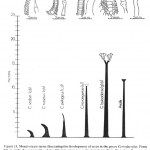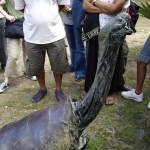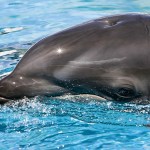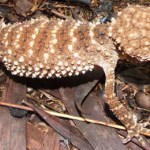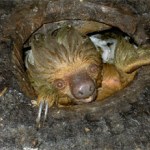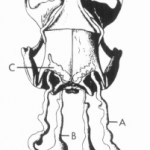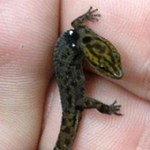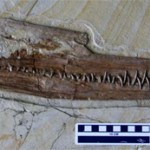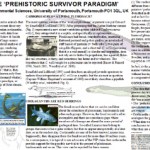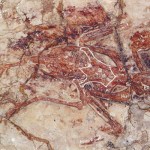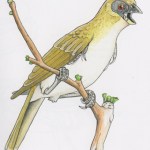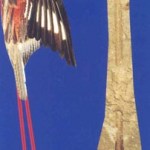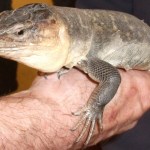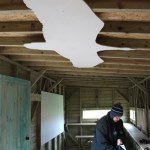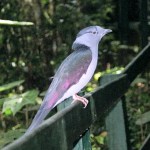
Another one. Identify the creatures (all from the Barremian Wessex Formation of the Isle of Wight, England) - possibly more difficult this time! Remember that some of the animals are in 'historic guise', so are portrayed very much inaccurately. And no cheating, as labelled versions of this picture have been published before (in the Japanese Dino Press magazine).
And sorry the image is so small: without publishing numerous close-ups, this is the only way I can get the whole image on the screen.
When I was a kid I drew lots of dinosaurs. My efforts weren't too bad, but of course I got a lot wrong (by modern standards) and - like so many dinosaur fan-boys and girls growing up in the 80s and 90s - I became a very good copier of Greg Paul. Here's a Late Cretaceous Mongolian scene I drew once (I cheated, as some of the animals shown here might never had met). Your challenge: name them.
As might be obvious, I always liked filling in all the little details. Plants, rocks, bugs and such. In fact, I always thought I might make a reasonably good mural artist: in Prehistoric Life Murals,…
Back to gekkotans: time to look at digits.
Geckos are well known for the ability of many species to cling to vertical surfaces, and even to ceilings. In fact, this is usually the one thing about geckos that everyone knows. The powers of gecko adhesion are such that geckos can support their entire weight while hanging from a single digit, they can remain stuck to leaves while exposed to 98 km/h winds, and they can also remain stuck to a surface when dead (Russell 1976). Expanded digital pads - called scansors or scansor pads - are lined on their undersides with rows of lamellae, and these…
It's official: there's a new, living species of African rhino, bringing the recognised number of living rhino species to six.
But before you get too excited I should point out that the taxon concerned is not exactly new. It was first named in 1908 and has previously been regarded (without exception) as a 'subspecies'.
It's the Northern or Cotton's white rhinoceros (aka Grass rhino or Square-lipped rhino) Ceratotherium cottoni [captive individual shown above; photo by Jan Robovsky, from Groves et al. (2010)], previously classified as Ceratotherium simum cottoni, and first named by Richard…
Until recently the Mascarenes were home to an endemic radiation of giant tortoises, the Cylindraspis species. These were entirely separate from the better known, more 'typical' Mascarene giant tortoises grouped together in Dipsochelys or Aldabrachelys (Austin & Arnold 2001). Easily the most remarkable Cylindraspis tortoise was C. vosmaeri from Rodrigues, sometimes called the Rodrigues saddle-backed tortoise...
As you can see from these life-sized models, C. vosmaeri was a veritable giraffe (or sauropod) among tortoises: we have a good idea of its appearance in life thanks to a (very…
Can you identify this peculiar odontocete? As always, dead easy. IF you know the answer. Thanks to Markus Bühler for the image.
Oh, and while I'm here...
On a completely different topic... I was once told that numerous birds die while flying close to or over offshore oil platforms [adjacent pic from wikipedia].
Supposedly, the birds are poisoned by the vented gases, and gather in some numbers on the decks. Is this complete nonsense, or might there be some truth to it? Can you provide more information? Having looked - and, believe me, I've spent a lot of time tracking down literature on…
More on gekkotans, and this time were going to look at various details of gekkotan anatomy. Gekkotans are, being lizards, lizard-shaped (though with the near-limbless pygopodids being snake-like). But what makes them really special is that certain parts of their bodies - in particular, their hands and feet, and often their tails - are highly specialised and mightily weird [images here - from wikipedia - show the fat-tailed eublepharid Hemitheconyx caudicinctus and the gekkonine Ptychozoon kuhli with its tessellated tail].
We'll start by looking at tails. Many gekkotans use the tail for fat…
I really like sloths, but one of their recently discovered habits might make me like them a little bit less...
As recently reported by Eckhard Heymann and colleagues, Linnaeus's two-toed sloths Choloepus didactylus at the Estación Biológica Quebrada Blanco in north-eastern Peru have developed the delightful habit of climbing into an outdoor latrine building, seeking out the latrine contents AND EATING THEM (Heymann et al. 2010).
The behaviour was first reported in November 2001 when a sloth was discovered hanging from the wooden bars within the latrine. "It was scooping with one hand from…
Now that the main gekkotan groups have been introduced, it's time to get down to some of the details. We begin with stuff on lifestyle and behaviour... [gekkotan motley below - mostly assembled from wikipedia - features (top, left to right) Aeluroscalabotes felinus, Pachydactylus bibronii, Rhacodactylus ciliatus and (bottom, left to right) Nephrurus amyae, Phyllodactylus xanti and Phelsuma madagascariensis].
Gekkotans are mostly insectivorous, but some of the large species prey on other lizards, and even on snails, birds, mammals (including bats) and small snakes. Nectar and pollen is eaten…
As you may know, Tet Zoo has been going for four years now. Despite this, there are still entire tetrapod clades - consisting of hundreds or even thousands of species - that have scarcely been mentioned here, if at all.
Lately, I've been feeling 'gecko guilt'. Yes, I can barely believe that the enormous squamate clade known as Gekkota has been all but unmentioned on these pages. I don't have time to give the group any sort of justice (sorry, Gekkota), but here is a very brief intro to the group and how neat it is (aaaaand, as usual I wrote this sentence long before completing what you're…
Earlier this year the awesome new ornithocheiroid pterosaur Zhenyuanopterus longirostris Lü, 2010 was described from the Yixian Formation of Liaoning Province, China. It has pretty incredible teeth, as well as a very interesting premaxillary crest...
And it has a lot of teeth: 86 in total in the upper jaw, and another 86 in the lower jaw (giving a total of 172). The teeth at the front of the upper jaw are about 50 mm long. This is a reasonably large pterosaur, with a wingspan of about 4 m (Lü 2010). It's clearly an ornithocheiroid, and it seems quite similar to another Yixian Formation…
This weekend (17th-18th April 2010), the 9th European Symposium of Cryptozoology is being held at Engreux in the south of Belgium. I meant to attend and give a talk, but had to cancel for financial reasons. And it's just as well that I did, given that virtually all flights from out of the UK have been cancelled due to the Icelandic eruption (the consequences of this eruption are interesting: the sky here in England is free of planes and contrails, and a very fine covering of ash covers cars and other objects). Anyway, my non-attendance in person meant that I was invited to submit a poster…
Yet another entry from the fieldguide (though substantially updated and enlarged)...
What might be one of the strangest Cretaceous birds was described in 2004. I refer of course to Aberratiodontus wui of the Jiufotang Formation of Liaoning Province, China.
Named for a near-complete specimen, Aberratiodontus was regarded by its describers (Gong et al. 2004) as one of the most unusual of the enantiornithines or 'opposite birds' (though read on!). In keeping with the tradition of Linnaean taxonomy, they gave it its own eponymous 'family' and 'order' (these being 'Aberratiodontuidae' and '…
Again, more recycled text from the Mesozoic bird section of the fieldguide...
Alexornis antecedens from the Upper Cretaceous (?Campanian) La Bocana Roja Formation of Mexico was first described in 1976; its remains were discovered in 1971 by H. J. Garbani and J. Loewe. The bones they found - various elements from the shoulder, wing and leg - were tiny, and evidently from a bird similar in size to a modern finch [adjacent life restoration by Ken Kirkland, from Hilton (2003)]
This discovery pre-dated the 1981 recognition of enantiornithines as a distinct group of Mesozoic birds (see the article…
When there's no time for anything else, at least I can recycle text from the aborted field-guide (see bottom for previous excerpts). Hmm, I really should get that published. Anyway...
Protopteryx fengningensis was named in 2000 for two specimens discovered in the Yixian Formation of Fengning County, northern China [adjacent figure from Zhang & Zhou (2000): the tail feather shown in C belongs to Confuciusornis, not Protopteryx]. It's an enantiornithine about the same size as a modern starling. As is common among Cretaceous birds, it had teeth in both its premaxillae and dentaries. Its…
Readers with good memories will recall both that January 21st 2010 was Tet Zoo's fourth birthday, and that I wrote about 'four years of operation' on that day. I had more to say about the subject in 2009, a year of Tet Zooery. Buuut... then things went downhill, and I had to take that break, and then all that other stuff happened, and - well - I ended up not finishing the 4th birthday series. Purely in the interests of publishing it and getting it out of the way (better late than never), herewith find the last, very belated, instalment in my thoughts on the whole fourth birthday thing [the…
I was thrilled and delighted to encounter this amazing beast at a recent meeting. It's another of those creatures that you might know well from the literature, but (you assume) are unlikely to ever see in the flesh. Yet here it is...
Your challenge: tell us all what it is. As usual, this is dead easy... so long as you know the answer. And, to those people who have already seen the photos on my Facebook wall: you are not allowed to play.
It's a good time to feature neat lizards, what with today's publication of the paper on the new Philippine monitor Varanus bitatawa (Welton et al. 2010).…
Over the weekend I and a bunch of friends and colleagues (representing the Southampton Natural History Society) went to Salisbury Plain, Wiltshire, in search of Great bustards Otis tarda.
The Great bustard (one of 26 or so bustard species found throughout the Old World and Australasia) is a British native, but excessive hunting and (probably) changing agricultural practises, increasing human disturbance and perhaps other factors led to its extinction as a breeding species round about 1832, though some eggs were apparently discovered in 1838 and it is suspected that some native birds were…
If anything should be clear from the range of creatures that I write about at Tet Zoo - think caecilians, borhyaenoids, imaginary giant owls and rhynchosaurs - it's that there's an almost infinite amount of technical information on obscure creatures 'locked away' in the technical literature. Among the most remarkable of mammals are, without doubt, the winged cats or pantheropterygines, yet for all their fame and notoriety, most of the information on these creatures has remained widely scattered in the literature and a good synthesis is absent.
Winged cats were first brought to scientific…
The Madagascan cuckoo-roller or Courol* Leptosomus discolor is a distinctive, large-headed, short-legged predatory bird that inhabits the forests of Madagascar and the Comores [adjacent photo of male Courol taken at Vakona in Madagascar; image courtesy of Mary Blanchard]. It's superficially similar to true rollers (Coraciidae) and ground-rollers (Brachypteraciidae) but, unlike them, has semi-zygodactyl feet (though it has frequently very depicted inaccurately by artists who, in the absence of better information, have assumed that it's anisodactyl, like true rollers). It's often placed in its…


